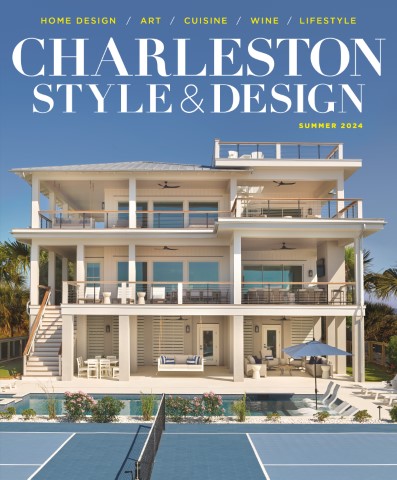
Katharine Flanders and her husband, Thomas, used to vacation in Murrells Inlet, South Carolina, when their two sons were teens. Decades later, when the couple decided she would sell her B&B and he his dental practice, trading Upstate New York for the balmy South Carolina coastal town was a no-brainer.
That’s the linchpin of the story of how Flanders ended her 42-year hiatus from art and restored it to a prominent place in her life.
The California-born painter, whose principal medium is acrylic pours on canvas, monitored the building of their new home during the 2017 transition year.

“After taking possession and unpacking boxes, I would watch painting videos and say, ‘I can do that.’ So I did,” says Flanders. “I am by nature a night owl, and I would just stay up all night and try different pouring techniques. My husband was still working his transition year for the company that bought his dental practice. He would fly home every Thursday night, then back to New York on Sunday. Monday through Wednesday I packed, unpacked and painted pretty much around the clock. There was no aha moment. It was just something I did.”
What brought her back? Time, opportunity and the support of her family, says Flanders, who also paints landscapes.
“For me, it was just something that was always there, and I returned to it when life afforded the opportunity. I painted in oils up until 1975, but that year our family dynamics changed, necessitating the break from painting,” Flanders explains. “I never severed myself from my love of art during that 42-year interruption. I bought art. If you truly love art, you cannot exclude it from your life. If you cannot create the art you love, you will simply buy the art you love.”
Today, she pours what she loves. The basic technique involves pouring or dripping liquid paint onto a canvas to create singular, unpredictable patterns and motifs. The fluid nature of the process can result in flowing compositions that, like all art, are open to interpretation. The so-called “dirty-cup” pour, in contrast to a clean pour, is defined by colors that intersect and form patterns amongst themselves.

Flanders takes it further.
“Those are techniques that are employed when one first begins acrylic pouring. I like ring pours, dips, flip cups, drags, swipes, string pulls and embellishments,” she says. “Sometimes it’s just fun to set out a bunch of small canvases and try everything! A Dutch pour, so named by Dutch artist Rinske Douna, is another lovely pouring method.”
Flanders says acrylic pours are also a fun, quick-fix (quick drying) form of painting, the kind that brings a smile to her face.
“I like art that makes me smile, and I want to create art that makes me smile,” she says. “I want to make others smile, as well. As much as I like oils, you cannot really paint in oils and turn around in two days and have it be dry enough to transport.”
The subject matter that compels her gaze usually resides in nature.

“I love the sky and the beach and the ocean when it’s calm and blue,” she says. “I also love azaleas, roses and camellias. It’s the colors. The colors are calming and happy all in one big ball of beauty.”
Flanders cites the work of Jean-Claude Picot, Yaacov Agam, Simon Bull and Donna Sharam as having been her chief professional influences. But she is also descended from a long line of self-taught female artists, including her mother, Sarah Short.
“Momma is the one who first encouraged me to paint,” Flanders says. “When I was a little girl, I would draw and color pictures for my brothers to put on their bedroom wall. Even when we had no money to spare for anything, Momma would somehow manage to buy me a canvas and a few paints and a brush. She and her sisters all painted beautiful landscapes and still lifes. One, Aunt Ruth, sculpted and taught classes. Another, Aunt Ethel, hand stitched the most beautiful quilts. A third, Aunt Mary, was a painter. Momma also made porcelain dolls, and her art and dolls won first place ribbons at shows. She can still pretty much do anything.”

Flanders says her work generally is a matter of approaching a piece with something specific in mind.
“I’m very black-and-white about nearly everything,” she says. “So, when I decide to paint, it’s because I have something I want to see. Now, in all honesty, most of my finished paintings don’t resemble anything I had in mind! As a result, Momma and Tom, my biggest supporters, usually name the pieces.”
Flanders, who celebrated her 44th wedding anniversary in January, hesitates to call herself a full-time artist, but her sense of purpose is no less strong, as is her community involvement in the arts. Flanders is a member of the Myrtle Beach Art Museum, the Rice Museum, the Waccamaw Arts & Crafts Guild, Seacoast Gallery and the Waccamaw Neck Arts Alliance. Whenever the opportunity arises, she tries to be available to participate in any of their respective events.
Ultimately, Flanders’ goal is to pass her love of creating art on to her grandchildren.
“If you have a talent that can enrich another, don’t take it to the grave,” she says. “Teach it to the next generation. I’m glad my mom passed on to me her love of painting.” *
Bill Thompson is the author of As Luck Would Have It, a memoir.

